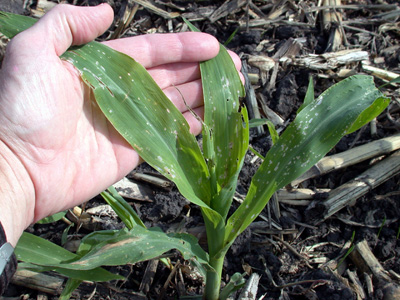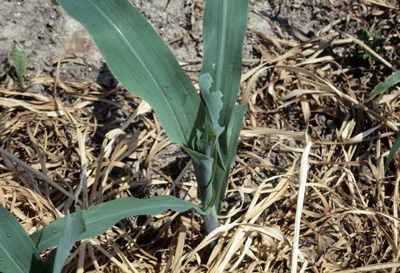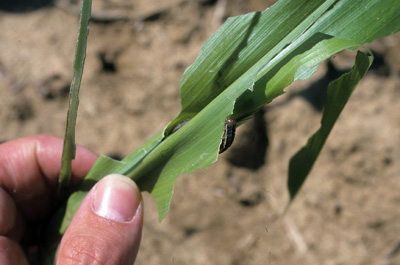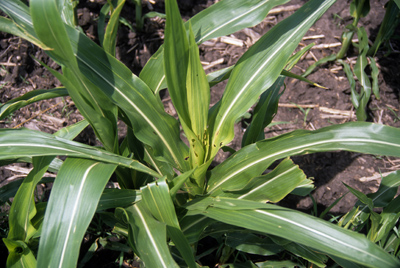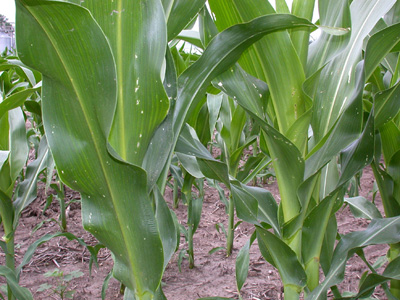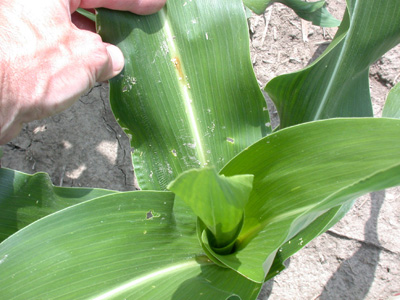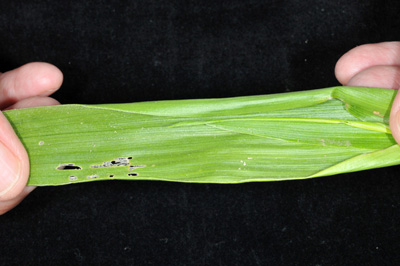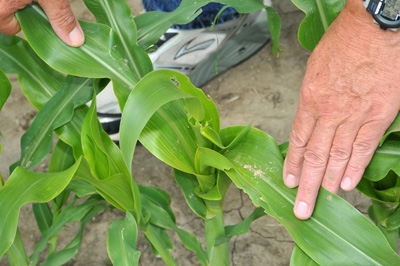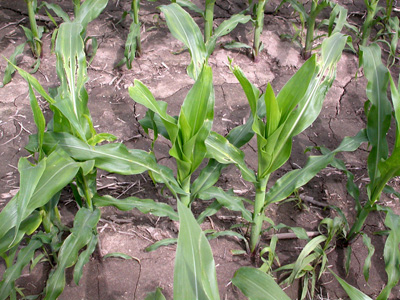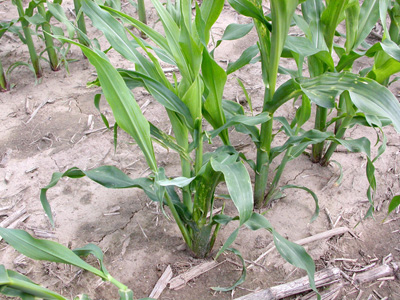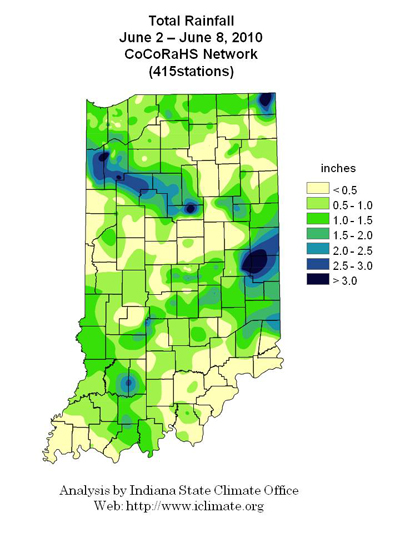Pest & Crop Newsletter, Entomology Extension, Purdue University
- Late Soybean Planting: Switch Maturity Groups?
- "Safe" Hybrid Maturities for Late Corn Planting in Indiana
Insect Damage to Whorl Corn, Who Done It? – (Christian Krupke and John Obermeyer)
For the most part, while driving Hoosier highways, corn is starting to look pretty good. While scouting (“ground-truthing”) whorl stage corn, occasional plants are showing leaf damage. Generally identifying the culprit is simple, by dissecting or unrolling the leaves and revealing the insect. Some, on the other hand, are either seeking refuge (e.g., under surface residues) or have completed their feeding and relocated. The following is a listing of the most likely pest possibilities with some pictorial support. Bottom line…know your enemy’s identification, damage symptoms, and biology. Happy scouting!
Who done it?
Armyworm – Armyworm feeding gives corn a ragged appearance, with defoliation occurring from the leaf edge toward the midrib. Damage may be so extensive that most of the plant, except leaf midribs and the stalk, is consumed. Most larval feeding is now complete, but a few stragglers may still be found in whorls or beneath residues near damaged plants. If one is really inquisitive, digging near the base of the plant may reveal a pupa in the soil.
Typical armyworm damage in early whorl corn
Armyworm revealed after unrolling damaged leaves
Stalk borer – Whorl stage corn plants attacked by this insect will show round to irregular shaped rows of holes through the unfolded leaves which may become tattered with time. Many plants will have an unnatural growth, being twisted or bent over, presenting a stunted appearance and may not produce an ear. Splitting open the length of the stalk may reveal a late-instar or pre-pupa larva. Stalk borer damage is more common near field borders or giant ragweed patches.
Late instar stalk borer damage
Stalk borer pre-pupa in stalk
European corn borer – With the advent of Bt-corn borer corn over a decade ago, this once major pest has become secondary. Because of this, an occasional non-Bt field is economically damaged if it is neglected during the first generation moth flight. Certainly a reminder that this once feared pest is not extinct, lying in wait for such an opportunity. As the borers feed on the leaves, they typically produce a characteristic random or “shot hole” damage pattern. These holes become apparent as the leaves grow out of the whorl. As the larvae feed and grow, some may be found tunneled into the midrib of leaves. This damage can cause leaves to break at the point of borer entry.
Shot-hole corn borer damage
Corn borer mid-rib damage
Corn earworm – Normally, moth arrival into the state isn’t until mid to later June. As mentioned in last week’s Pest&Crop, we captured corn earworm moths the second week of May. Because of this, moths will lay eggs on whorl stage corn because silks aren’t yet available. Early larval instar damage is similar to corn borer, that is “window-paning” and/or a shot hole pattern. Larger larvae create a mess in the whorl, which is often described as “blasted,” and is likened to fall armyworm damage. Severe feeding may give the appearance of corn that has been damaged by hail.
Window pane feeding scars from early instar corn earworm
As the corn earworm increase in size, so does its damage
Stink bug – Unlike the previously mentioned lepidopterous insects with chewing mouth parts, stink bugs stick their tubular mouth parts into the plant tissue and suck the plant juices. They inject an enzyme into the plant, which helps digest the plant tissue. The plant tissue at or near the feeding site will show some form of injury. This could result in partial destruction to the plant tissue or plant deformity, such as irregular twisting or growth of the stalk. Plant damage is most evident after plant growth stage V5. These plants will often have round to elongate holes in the rapidly expanding leaves, the holes can vary somewhat in size. The holes seem to always be ringed with plant tissue that has turned yellow; the edge of the hole is generally transparent. Although these holes may appear to have been caused by a chewing insect, closer examination reveals that they have been caused by a piercing of the leaf while it was still small and rolled up in the stalk or whorl. Other above ground symptoms often observed included suckering (tillering) and other forms of growth deformity. In some cases the plants may split open, leaving a ragged brown slit in the side of the stalk. A jelly-like substance produced by the plant may be evident in the damaged area. Plant dissections often reveal that the growing point has been injured or killed, and the damage appears to be most serious in small plants. Damage symptoms by stink bug damage is seen weeks after feeding occurred.
Stink bug feeding above the growing point causes elongated holes and tattered/torn leaves
Stink bug feeding at or near the growing point causes suckering
![]()
Click here to view the Black Light Trap Catch Report
Late Soybean Planting: Switch Maturity Groups? – (Shaun Casteel)
Indiana soybean planting started fast with approximately 20% by the beginning of May and nearly 50% by the middle of May. Then, field work slowed as the temperatures cooled and the rainy days followed. Planting progress over the past two weeks has mirrored the 5-year average (though two of those five included very wet springs). As of June 6th, 81% of Indiana’s soybean acres were planted. However, a few areas of the state have saturated fields that received rain over the past couple of days with a potential for more in the coming week. The question for these areas is: “Do we need to switch maturity groups?”
Soybeans planted at this point will probably yield ~90% of the yield of soybeans planted at a normal date. In another 10 days, this yield potential reduces to 78% of a normal yield (Table 1). The full-season varieties of soybean should still be planted until June 15th in the northern one-fourth of the Indiana, June 20th for the central one-half of Indiana, and June 25th in the southern one-fourth of Indiana. Full-season variety of soybean should be switched to mid-season variety after June 15, 20, and 25 for the northern, central, and southern regions of Indiana, respectively. In other words, decrease the maturity by one-half assuming that the variety being grown is a full-season variety for that area of the state.
Seeding rates should be increased by 15 to 20% to promote canopy closure to capture sunlight for photosynthate production, while shading out competing weeds. Additionally, the soybean-to-soybean competition will promote taller plants and subsequently the first reproductive node will be set higher to aid in harvest efficiency. Increased seeding rate will also increase the number of nodes per acre and increase the opportunity to maximize yields for the delayed planting.
| Planting Date | Yield as a % of Normal for | |
|---|---|---|
| Mid-Season Variety | Full-Season Variety | |
| May 20 | 100 | 100 |
| May 30 | 96 | 94 |
| June 10 | 92 | 90 |
| June 20 | 82 | 78 |
| June 30 | 70 | Not Recommended |
| July 10 | 601 | Not Recommended |
| 1In Indiana, south of Interstate 70 only. | ||
![]()
“Safe” Hybrid Maturities for Late Corn Planting in Indiana – (Bob Nielsen)
Some Indiana crop producers may yet be wanting to plant “first crop” corn acres or are facing possible late replant situations. Such late plantings are obviously not favorable for optimum corn yields, but some growers have their reasons for sticking with corn planting at this time of the season. One of the biggest concerns with late planting is the risk of the crop not reaching physiological maturity before a killing fall freeze and so folks need to be substituting earlier hybrid maturities for later ones by this of the year.
The tables that accompany this article list “safe” relative hybrid maturities for corn planted as late as June 10, 15, and 20 based on their heat unit requirements (adjusted for planting date) and anticipated “normal” accumulation of heat units between planting and an average date (50% probability) of a killing fall freeze. It should be no surprise that changes in hybrid maturity decisions are most evident for late planting in the northern and central areas of Indiana.
The maturities listed in the first table are those that should reach physiological maturity at least by the week when a killing fall freeze occurs, while the second table lists hybrid maturities that should mature at least by the week PRIOR to a killing fall freeze. When making a decision to plant corn this late with hybrid maturities that are unusually early for your area of the state, make the effort to identify hybrids with good disease resistance traits.
Recognize that while the hybrid maturities listed in either table should safely mature by their respective dates, they will mature at a time in the fall when further grain drying in the field typically occurs at a proverbial snail’s pace. Thus, grain moisture at harvest may be unacceptably high in terms of both the ease of harvest and the costs of artificially drying the grain.
Related References
Nielsen, Bob. 2002 (rev). Estimating Yield and Dollar Returns From Corn Replanting. Purdue Univ. Cooperative Extension Service publication AY-264-W. Online at <http://www.agry.purdue.edu/ext/pubs/AY-264-W.pdf>. [URL accessed June 2010].
Nielsen, R.L. (Bob). 2009. Interpreting Corn Hybrid Maturity Ratings. Corny News Network, Purdue Univ. [online] <http://www.kingcorn.org/news/timeless/HybridMaturity.html>. [URL accessed June 2010].
Nielsen, R.L. (Bob) and Peter Thomison. 2003. Delayed Planting & Hybrid Maturity Decisions. Purdue Univ. Cooperative Extension Publication AY-312-W. [On-line]. Available at <http://www.agry.purdue.edu/ext/pubs/AY-312-W.pdf>. [URL accessed June 2010].
Nielsen, Robert L., Peter R. Thomison, Gregory A. Brown, Anthony L. Halter, Jason Wells, and Kirby L. Wuethrich. 2002. Delayed Planting Effects on Flowering and Grain Maturation of Dent Corn. Agron. J. 94:549-558.
| Crop Rpt DIstrict | "Typical" CRM | Expected Fall Frost Date | Planting Date | ||
|---|---|---|---|---|---|
| 10-June | 15-June | 20-June | |||
| Approx. "Safe" Relative Maturity | |||||
| NW | 109 | 6-Oct. | 104 | 102 | 99 |
| NC | 109 | 6-Oct. | 104 | 101 | 99 |
| NE | 109 | 6-Oct. | 102 | 100 | 97 |
| WC | 112 | 13-Oct. | 114 | 111 | 108 |
| C | 112 | 13-Oct. | 111 | 109 | 106 |
| EC | 109 | 6-Oct. | 104 | 102 | 99 |
| SW | 116 | 20-Oct. | 118+ | 118+ | 118+ |
| SC | 113 | 13-Oct. | 118 | 115 | 112 |
| SE | 113 | 13-Oct. | 118+ | 117 | 113 |
| 50 pct fall frost risk date | |||||
| Approx. "safe" relative maturities for late planting dates in Indiana iwth an objective that the hybrid matures one week before the expected fall frost date. | |||||
| Crop Rpt DIstrict | "Typical" CRM | Expected Fall Frost Date | Planting Date | ||
| 10-June | 15-June | 20-June | |||
| Approx. "Safe" Relative Maturity | |||||
| NW | 109 | 6-Oct. | 102 | 99 | 97 |
| NC | 109 | 6-Oct. | 101 | 99 | 96 |
| NE | 109 | 6-Oct. | 99 | 97 | 94 |
| WC | 112 | 13-Oct. | 111 | 108 | 105 |
| C | 112 | 13-Oct. | 109 | 106 | 103 |
| EC | 109 | 6-Oct. | 102 | 99 | 97 |
| SW | 116 | 20-Oct. | 118+ | 118+ | 118 |
| SC | 113 | 13-Oct. | 115 | 113 | 109 |
| SE | 113 | 13-Oct. | 117 | 114 | 110 |
| 50 pct fall frost risk date | |||||
The Crop Reporting Districts are those defined y the National Ag. Statistics Service, USDA, for Indiana. The acronym "CRM" refers to Conparative Relative Maturity as defined by Pioneer Hi-Bred.

